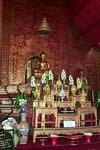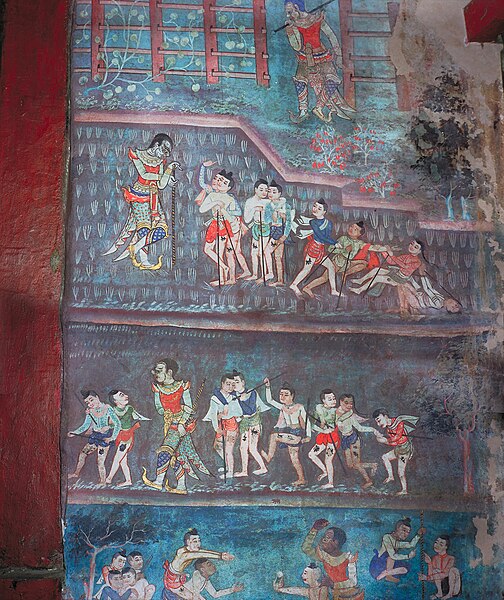Wat Phra Singh
 The altar at right is the one inside the large chapel. It's
beautiful, though rather standard for Thai temples these days. We were
somewhat amused by the plethora of "account books" strewn about on the
right side of the altar (behind the columns in the picture we're
afraid). In any temple that gets visitors, there is almost always a
donation box with a guest book for you to write your name and amount
donated in. Well, in this temple there were at least half a dozen
boxes, each with a different purpose - maintenance of the temple
building, electricity, taxes, etc. - and so each with its own account
book. Upon making a donation to one or more purpose, you then have to
scrabble around for the proper book to write it down in.
The altar at right is the one inside the large chapel. It's
beautiful, though rather standard for Thai temples these days. We were
somewhat amused by the plethora of "account books" strewn about on the
right side of the altar (behind the columns in the picture we're
afraid). In any temple that gets visitors, there is almost always a
donation box with a guest book for you to write your name and amount
donated in. Well, in this temple there were at least half a dozen
boxes, each with a different purpose - maintenance of the temple
building, electricity, taxes, etc. - and so each with its own account
book. Upon making a donation to one or more purpose, you then have to
scrabble around for the proper book to write it down in.
You can take it with you.
Wish you could have this information with you when you visit Chiang Mai? Now you can. Check out our ebook guides.
Wish you could have this information with you when you visit Chiang Mai? Now you can. Check out our ebook guides.
As you face the big wiharn, to your right is a small elaborate ho trai (library) built on a high stone base. The base has many beautiful carvings which have recently been renovated, as have the gilded carvings on the gable ends. Continuing on around the complex in a counter-clockwise direction, you'll find a drum tower set in a yard shaded by many old trees. Sometimes there's an artist or two at work here, and selling their work of course.
 Directly behind the large prayer hall is a smaller building that serves as the temple's ordination hall (ubosot).
This is where young monks are ordained and some other important
religious events are held. The wooden building shelters a large brick
and plaster altar, that I suspect pre-dates the outer building and was
originally out in the open. The clues to this are the altar's shape and
the fact that it sits in the middle of the building rather than at one
end. The orientation of the entrances on a north - south axis rather
than east - west is another clue. Like the library, the ubosot has recently been restored.
Directly behind the large prayer hall is a smaller building that serves as the temple's ordination hall (ubosot).
This is where young monks are ordained and some other important
religious events are held. The wooden building shelters a large brick
and plaster altar, that I suspect pre-dates the outer building and was
originally out in the open. The clues to this are the altar's shape and
the fact that it sits in the middle of the building rather than at one
end. The orientation of the entrances on a north - south axis rather
than east - west is another clue. Like the library, the ubosot has recently been restored.
Next to the ubosot, in a line with the wiharn, is a large whitewashed pagoda (chedi). Next to it is a small but very ornate Wiharn which is worth a closer look. The outside is decorated in gold and ochre in a style which is ornate but without the gaudiness of many other temples.
The decoration inside is also quite rich. There is a brocade-like gold and red pattern on parts of the roof and back wall behind the altar. On the altar here (and not on the altar of the main wiharn) sits the Phra Singh Buddha image from which the temple takes its name. "Phra" is Thai for a priest or cleric and also used to refer to Buddha images. "Singh" means lion, but may be a corruption of the Thai word for Sri Lanka, where the image is supposed to come from.
Wat Phra Singh was founded in the 14th century to enshrine the ashes of King Kam Fu.
From Wat Phra Singh, you might want to go on to Wat Chedi Luang, which is just a short walk away. Another important temple within the walls is the oldest: Wat Chieng Man. It's another short walk away, near the Chang Puak gate and the Thai Airways ticket office.
Location
Wat Phra Singh is located in the western part of the old city centre of Chiang Mai, which is contained within the city walls and moat. The main entrance, which is guarded by Singhs (lions), is situated at the end of the main street (Rachadamnoen road) of Chiang Mai. The road runs east from the temple, via Tapae Gate, to the Ping River.Notability
The temple houses an important Buddha statue: the Phra Buddha Sihing which gives the temple its name. The origins of this statue are unknown but, according to legend, it was based on the lion of Shakya, a statue since lost which used to be housed in the Mahabodhi Temple of Bodh Gaya (India). The Phra Buddha Sihing statue is supposed to have been brought, via Ceylon (present day Sri Lanka), to Ligor (present day Nakhon Si Thammarat and from there, via Ayutthaya, to Chiang Mai. There are two more Buddha statues in Thailand which are claimed to be the Phra Buddha Sihing: one is housed in Wat Phra Mahathat in the city of Nakhon Si Thammarat and another in the Bangkok National Museum.It is alleged that the head of the statue had been stolen in 1922. The possibility remains that the present statue (or maybe only the head) is a copy.
Every year, during the Songkran festival, the statue is taken from Wihan Lai Kham and carried through the streets of Chiang Mai in a religious procession during which the spectators honour the statue by sprinkling water over it.
History
Construction on Wat Phra Singh began in 1345 when King Phayu, the fifth king of the Mangrai dynasty, had a chedi built to house the ashes of his father King Kham Fu. A wihan and several other buildings were added a few years later and the resulting complex was named Wat Lichiang Phra. When, in 1367, the statue of Phra Buddha Singh was brought to the temple, the temple complex received its present name. During restoration works in 1925, three funerary urns were discovered inside a small chedi. It was assumed that these contained royal ashes. The urns have since been lost. From 1578 to 1774 the Burmese ruled Lanna and in this period the temple was abandoned and came under serious disrepair. It was only when King Kawila assumed the throne as King of Chiang Mai in 1782, that the temple was restored. King Kawila had the ubosot built and the chedi enlarged. Later successors restored the Wihan Lai Kham and the elegant Ho Trai (temple library).The whole temple complex underwent extensive renovations under the famous monk Khru Ba Srivichai during the 1920s. Many of the buildings were again restored in 2002.
Sights
- Wihan Luang - the original wihan was replaced by the present building in 1925.
- Wihan Lai Kham - this wihan is the main attraction of the complex. It was built in 1345 to house the Phra Buddha Singh statue and it is a prime example of classical Lanna architecture. The murals of the wihan are also highly remarkable. The murals on the left show the history of Songthong and on the right the history of Suwanna Hongse.
- Ubosot - built in 1806, it contains two entrances: a south entrance for monks and a north entrance for nuns. It is as such a song sangha ubosot ('song' meaning 'two' in Thai). The building houses a mondop with the Phrachaotongtip Buddha statue, a smaller version of the Phra Buddha Sihing and it is therefore also known as Phrasingha noi ('noi' meaning 'small' in Thai). The northern end of the wihan, near the entrance for the nuns, contains a copy of the Emerald Buddha.
- Ho Trai - the temple library is another prime example of classical Lanna architecture and it is one of the most beautiful temple libraries in Thailand. The guards, flanking the stairs, consist of lions emerging from the mouths of a Makara, a mythical water creature. This combination is rarely seen elsewhere.
- The Phrathatluang - each side of the square base of the main chedi of the complex features the front half of an elephant emerging from it. After it was built in 1345, the chedi was enlarged several times.
- The Kulai chedi - this small square based chedi, built as a pagoda with five tiered roofs by King Mueangkaeo (1495-1525), is connected to Wihan Lai Kham by a short tunnel which is not opened to visitors. When the chedi was restored under King Dharmalanka (1813-1822), a golden box containing ancient relics was found. After the works were completed, the box and its contents were placed once more inside the chedi.
Map
ดูแผนที่ขนาดใหญ่ขึ้น
Videos
Gallery
http://en.wikipedia.org/wiki/Wat_Phra_Singh
http://thailandforvisitors.com/north/chiangmai/cm-temps.html




No comments:
Post a Comment